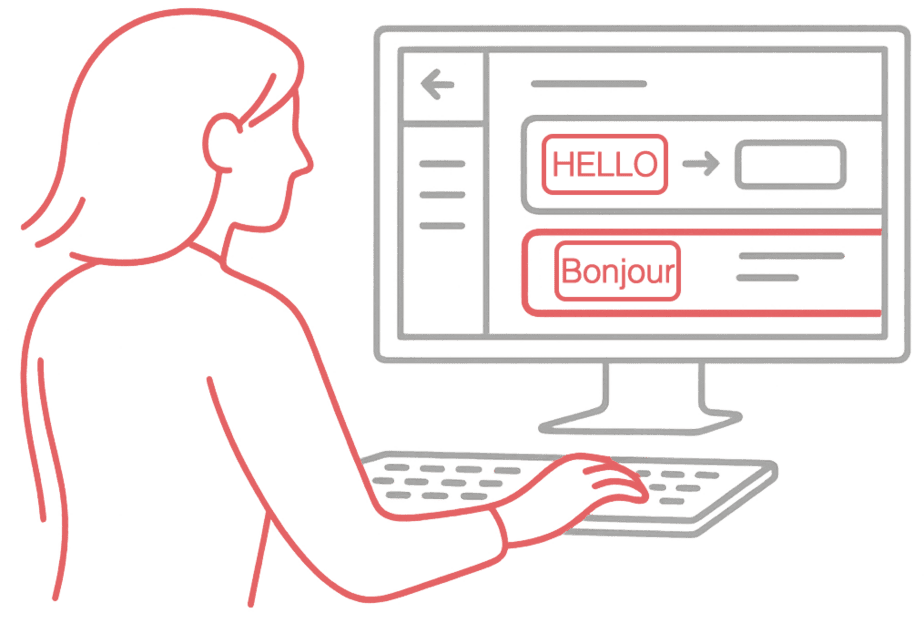
In-Context UI Localization for Faster, More Accurate Software Translation
Stepes’ proprietary in-context localization platform lets translators work directly within your live software interface for unmatched accuracy and speed.
Why In-Context Localization Matters
In traditional software localization, translators often work with isolated text strings stored in spreadsheets or resource files. Without visual context, it is difficult to understand where each phrase appears in the user interface, how much space is available, or what the surrounding elements mean. This lack of visibility frequently results in truncated text, inconsistent terminology, and multiple rounds of UI QA.
Stepes eliminates these inefficiencies through real-time in-context localization, allowing linguists to translate directly within the live interface. Translators see exactly how text appears on buttons, menus, dialogs, and screens while they work, ensuring accurate, layout-ready translations that require minimal post-editing.
By integrating translation directly with the software’s visual environment, Stepes bridges the gap between language and design, improving quality, efficiency, and release speed across all localized versions.
Key Benefits
- Translations fit precisely within interface layouts
- Real-time visual context improves accuracy and consistency
- Fewer QA iterations and layout corrections
- Shorter release cycles across multiple languages
Comparison Table
| Traditional Localization | Stepes In-Context Localization |
| Strings translated in spreadsheets | Translated directly within the live interface |
| Frequent truncations and UI issues | Layout-accurate translations with visual preview |
| Multiple QA passes required | Streamlined workflow with fewer post-fixes |
| Long and fragmented release timelines | Faster go-to-market delivery with integrated localization |
How Stepes In-Context Localization Works
Stepes has developed one of the industry’s first in-context UI translation systems for modern software localization. The platform connects directly to your design and development environments so translators can view, translate, and validate every string as it appears in the live interface. This eliminates guesswork, reduces layout issues, and improves translation accuracy before deployment.
The in-context workflow integrates seamlessly with agile and continuous localization pipelines, allowing engineering and linguistic teams to collaborate in real time. Translators see dynamic UI components, contextual tooltips, and text-length constraints as they work, producing high-quality, layout-ready translations that align with design intent and user experience standards.
- Connect
Sync UI strings from source files, design tools, or repositories such as Figma, Sketch, GitHub, and Bitbucket. Stepes automatically maps text elements to their visual positions within the interface.
- Translate
Linguists translate and review content directly inside the live UI using Stepes’ interactive visual environment. Real-time preview ensures every translation fits perfectly and reads naturally within its context.
- Publish
Final translations are exported to your code base, CMS, or localization repository through automated integrations and RESTful APIs. This enables continuous updates and immediate deployment to staging or production environments.
Built for Agile and Continuous Localization
Stepes is engineered for agile software development and continuous localization (CL), enabling real-time translation updates across all product releases. Our platform integrates directly into your DevOps pipelines through continuous integration and continuous deployment (CI/CD), allowing language updates to move at the same speed as code.
With Stepes, localization becomes an automated extension of your development process. Translations are triggered automatically when new strings are committed, merged, or updated in your repositories. This ensures global releases remain synchronized across languages without manual file exchanges or delays.
Stepes also connects with design systems and source control tools, giving developers, product managers, and translators a unified environment for managing multilingual UI assets. The result is a streamlined workflow that reduces overhead, shortens localization cycles, and improves cross-functional collaboration.
- Syncs with GitHub, GitLab, and Bitbucket for continuous localization
- Connects with Figma and Sketch to manage visual and design assets
- RESTful API enables automated localization updates and deployments
- Supports string-based workflows including JSON, RESX, XML, and XLIFF
- Compatible with modern frameworks such as React, Angular, Vue, iOS, and Android
Powered by Stepes Technology
Stepes’ in-context localization is powered by advanced translation technology built specifically for modern software development environments. The Stepes In-Context Translation Engine combines linguistic intelligence, automation, and real-time visualization to deliver accurate, layout-ready translations across all platforms.
The system dynamically maps every text string to its exact location in the user interface. Translators see live previews of how text appears in menus, dialogs, and buttons as they work. This real-time visual feedback ensures that translated content fits properly within layout constraints, maintains UI consistency, and preserves design integrity across languages.
Stepes technology also integrates translation memory, terminology management, and automated QA within a secure, cloud-based environment. Each translation is validated for length, truncation risk, and formatting compliance before delivery. The result is a fully integrated localization workflow that enhances speed, accuracy, and scalability for enterprise software releases.
Key Features
- Proprietary Stepes In-Context Translation Engine for live UI string mapping
- Real-time visual QA to validate layout and design accuracy
- Integrated terminology and translation memory for linguistic consistency
- Automated string validation and truncation detection before export
- Secure cloud-based environment for global team collaboration
Why Leading Software Brands Choose Stepes
Stepes is the preferred localization partner for leading software companies seeking precise, scalable, and cost-efficient multilingual UI translation. Our platform unites human linguistic expertise with advanced in-context localization technology to deliver consistently accurate results across all digital interfaces.
We understand the challenges software teams face when scaling globally, including layout inconsistencies, truncated strings, and time-consuming QA cycles. Stepes solves these problems with a streamlined workflow that combines real-time in-context translation, continuous localization integration, and certified language quality. Every translation project benefits from expert linguists specialized in software UI terminology and supported by ISO-certified processes to ensure linguistic and functional accuracy.
Stepes’ end-to-end approach extends beyond interface translation to cover documentation, help content, and multilingual UX testing, giving software teams a complete solution for international product readiness.
Key Differentiators
- 100 supported languages across global markets
- Professional native translators with specialized software expertise
- ISO 17100 and ISO 9001:2015 certified localization workflows
- Continuous localization and CI/CD pipeline integration
- Proprietary Stepes In-Context Translation System that eliminates context-related errors
- End-to-end coverage from UI strings, user documentation, and product help content
In-Context Localization in Real Projects
Stepes’ in-context localization technology has delivered measurable results for global software organizations by improving translation accuracy, accelerating release timelines, and reducing QA workloads. Our clients, including SaaS providers, enterprise platform developers, and mobile app companies, have achieved consistent multilingual UI performance while streamlining their international rollout processes.
By enabling translators to work directly within live interfaces, Stepes helps product teams identify and resolve UI issues during translation instead of after deployment. This proactive approach improves design alignment, reduces engineering rework, and ensures faster market readiness across languages.
Example Case Highlight
A leading SaaS company reduced post-localization UI fixes by 43 percent after adopting Stepes’ in-context translation system. The client reported faster validation cycles, higher translation accuracy, and improved overall user experience across 12 localized product versions.
Frequently Asked Questions
This section addresses common questions about in-context software localization, helping teams understand how Stepes’ technology improves translation accuracy, efficiency, and release readiness. Designed in accordion format, each FAQ enhances user experience and supports SEO with structured data for rich results.
In-context software localization is a process that allows translators to work directly within the live user interface. Translators can view where each text string appears in the software, ensuring that translations fit correctly within the layout and convey the intended meaning. This approach eliminates the guesswork associated with traditional text-only localization workflows.
Traditional localization separates content from its design environment. Translators typically work with isolated text files or spreadsheets, which increases the risk of truncation and contextual errors. In-context localization displays every string within its actual interface location, allowing translators to produce layout-accurate and user-friendly translations in real time.
In-context localization is ideal for web applications, SaaS platforms, mobile apps, enterprise systems, and embedded interfaces. Any product with dynamic UI elements or limited screen space benefits from visual translation workflows that maintain consistency, usability, and design accuracy across languages.
Yes. Stepes fully supports agile development environments through continuous localization (CL) and CI/CD integration. Translation updates are automatically triggered when new strings are committed or modified, allowing multilingual versions to stay synchronized with ongoing product development.
Absolutely. Stepes offers interactive demos that show how translators work within the live UI to deliver precise, layout-ready translations. Contact our team to schedule a demonstration and see how in-context localization can improve your global software release workflow.
Accelerate Your Global Software Launch
Transform the way you localize software with Stepes’ in-context UI localization. Our technology delivers precise, layout-ready translations that reduce QA cycles, shorten release timelines, and improve multilingual user experiences. Learn more about our full range of Software Localization Services.
